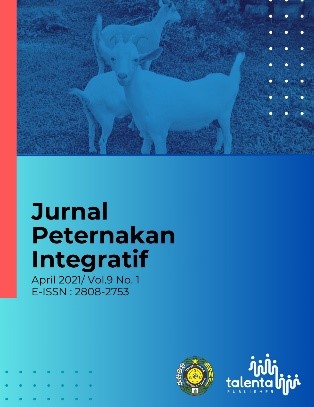Financial Analysis of Laying Ducks on People's Farms in Air Batu District, Asahan Regency
DOI:
https://doi.org/10.32734/jpi.v9i1.6486Keywords:
financial, laying ducks, smallholder livestockAbstract
Business productivity at the farm level is still low when compared to commercial businesses both in terms of business management, quality and quantity of production.This study aims to analyze financial aspects of laying ducks on community farms. The research was conducted in Air Batu Subdistrict, Asahan Regency in June until August 2020. The samples were determined by stratified sampling, namely dividing three business scales based on the number of livestock ownership, i.esmall-scale business (150-340 ducks), medium scale business (350- 500 ducks) and the highest scale business (550-800 ducks) with the number of respondents per business scale of 3 breeders. Parameters were production cost, income. revenue, R/C, BEP, Net B/C, Gross B/C, NPV, IRR, and PP. The results of the study showed that the average income per period per business scale was Rp. 32.792.167, - Rp. 112.390.667, - and Rp. 207.431.867. R / C value> 1, the value of BEP production is smaller than the amount of egg production, BEP price is smaller than the selling price of eggs per egg, the value of Net B / C and Gross B / C> 1, the NPV value> 0 or positive, the IRR value with an interest rate of 16.75%, respectively, is 26%, 27% and 27% greater than the interest rate and PP, respectively 4,3,2 months before the project age (5 years).
Downloads
Downloads
Published
Issue
Section
License
Copyright (c) 2021 Jurnal Peternakan Integratif

This work is licensed under a Creative Commons Attribution-ShareAlike 4.0 International License.
The Authors submitting a manuscript do so on the understanding that if accepted for publication, copyright of the article shall be assigned to Jurnal Peternakan Integratif as well as TALENTA Publisher Universitas Sumatera Utara as the publisher of the journal.
Copyright encompasses exclusive rights to reproduce and deliver the article in all forms and media. The reproduction of any part of this journal, its storage in databases and its transmission by any form or media, will be allowed only with written permission from Jurnal Peternakan Integratif.
The Copyright Transfer Form can be downloaded here.
The copyright form should be signed originally and sent to the Editorial Office in the form of original mail or scanned document.















